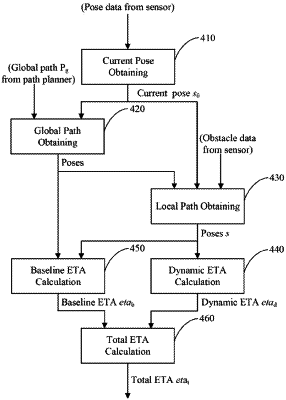| CPC G01C 21/005 (2013.01) [G01C 21/206 (2013.01)] | 20 Claims |

|
1. A computer-implemented method for calculating estimated time of arrival of a mobile machine to a destination, comprising:
receiving a request for the estimated time of arrival of the mobile machine to the destination, and obtaining a current pose of the mobile machine in response to the request;
obtaining a global path from the current pose of the mobile machine to the destination;
obtaining a local path planned based on the global path and the current pose of the mobile machine, wherein the local path and the global path comprise a plurality of poses for the mobile machine;
calculating a dynamic estimated time of arrival for each pair of consecutive poses in the local path by performing a calculation of a pose-to-pose estimated time of arrival on the each pair of the consecutive poses in the local path, and summing the calculated dynamic estimated time of arrival for all the pairs of the consecutive poses in the local path to obtain a summed dynamic estimated time of arrival, wherein the pose-to-pose estimated time of arrival is a duration of a movement of the mobile machine between a pair of consecutive poses;
calculating a baseline estimated time of arrival for each pair of consecutive poses between a first pose and a second pose in the global path by performing the calculation of the pose-to-pose estimated time of arrival on the each pair of the consecutive poses between the first pose and the second pose in the global path, and summing the calculated baseline estimated time of arrival for all the pairs of the consecutive poses between the first pose and the second pose in the global path to obtain a summed baseline estimated time of arrival, wherein the first pose is a pose closest to a last pose in the local path among the plurality of poses in the global path, and the last pose in the local path is a pose closest to the destination among the plurality of poses in the local path, and wherein the second pose is a pose closest to the destination among the plurality of poses in the global path;
obtaining a total estimated time of arrival of the mobile machine to the destination based on the summed dynamic estimated time of arrival and the summed baseline estimated time of arrival; and
navigating, by a navigation system of the mobile machine, the mobile machine according to the total estimated time of arrival of the mobile machine to the destination.
|